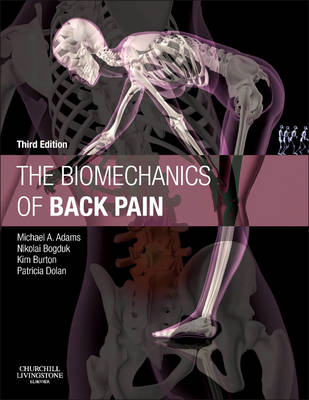
The Biomechanics of Back Pain
Churchill Livingstone (Verlag)
978-0-7020-4313-0 (ISBN)
Authored by experts of international renown, the new edition of The Biomechanics of Back Pain forms a bridge between the latest research and the effective clinical management of patients with back problems. Now published for the first time in full colour, this popular volume now has a bonus website which contains useful PowerPoint presentations, including seminars entitled Back Pain and Forces on the Spine as well as an overview of the Psychosocial Flags Framework.
The Biomechanics of Back Pain is essential for all clinicians involved in the care and treatment of patients with back pain, as well as for those studying its causes and methods of prevention.
"As more than half the content of this book is of direct relevance to OH professionals, I have no hesitation in recommending that it has a place on our bookshelves." Reviewed by: John Challenor, Oxford Journals Clippings, Occupational Medicine, vol 64, no 7, Date: Oct 2014
Established authoritative text for clinicians, lecturers, researchers and those working in the medico-legal arena
Emphasizes the latest perspectives in research and shows how it is now leading to advances in clinical methodology
Provides an overview of the best original research - including more than 350 new references - to provide researchers with the latest and most important information relating to back pain
Contains over 150 full-colour line artworks and more than 60 photographs
Additional chapters devoted to Sensorimotor Control, and Cervical Spine Anatomy and Biomechanics
Includes more than 350 new references
Now published in full colour with improved page design and navigation
Bonus website containing useful PowerPoint presentations, which include seminars entitled Back Pain and Forces on the Spine as well as an overview of the Psychosocial Flags Framework
I commenced research into spinal pain, in 1972, when essentially nothing was known about the problem. There being no established groups or departments working on this problem, I forged my own career, using borrowed resources. I commenced in a Department of Anatomy, where I pursued the innervation of the vertebral column as a fundamental element in understanding the sources and mechanisms of spinal pain. Professor Jim Lance fostered this interest, and accommodated my PhD studies. In his department I continued my anatomy studies but was able also to commence clinical applications. I developed and tested new diagnostic and surgical procedures for back pain and for neck pain. While in Professor Lance's Department, I participated in laboratory studies of the mechanisms of migraine. At the University of Queensland I continued to develop and apply the diagnostic and surgical techniques that I started at the University of NSW, serving as an honorary medical officer at the Pain Clinic of Princess Alexandra Hospital. Meanwhile I supervised science and medicine postgraduate students who undertook basic science studies into the biomechanics of the back and neck. At the University of Newcastle, I had established a reputation sufficient to attract a grant from the Motor Accidents Authority of NSW to investigate the cause and treatment of neck pain after whiplash. The grant supported three PhD students over a six year period. They performed studies that validated the diagnostic procedures and which tested the surgical procedures in a placebo-controlled double-blind randomized trial. Having established an international standing in the development and testing of treatments for spinal pain, I participated in the design and analysis of controlled trials conducted elsewhere in Australia and in the USA. These tested the efficacy of: lumbar radiofrequency neurotomy for back pain, intradiscal electrothermal anuloplasty for back pain, prolotherapy for back pain, exercises for neck pain. Between 1997 and 2002 I conducted the National Musculoskeletal Medicine Initiative which developed and tested evidence-based practice guidelines for the management of back pain, neck pain, shoulder pain, knee pain, and pain in the foot, wrist, and elbow. My work has been awarded the Volvo Award for Back Pain Research, the Research Prize of the Cervical Spine Research Society, the Award for Outstanding Research of the North American Spine Society, and three times the Research Prize of the Spine Society of Australia. My students have been awarded research prizes by the International Association for the Study of Pain, the Australian Rheumatology Association, and the Australian New Zealand College of Anaesthetists. I have never had a funded department to which to attract investigators and academics. I have relied on scholarships for students, and the goodwill of private practitioners who wished to contribute to clinical research. Of late, I have been supervising Neurosurgery residents undertaking studies of the outcomes of treatment for Radicular pain and back pain.
1. Introduction
2. The vertebral column and adjacent structures
3. Muscles and fascia of the lumbar spine
4. Nerves and blood supply to the lumbar spine
5. Back pain
6. Epidemiology of back trouble
7. Biology of spinal tissues
8. Growth and ageing of the spine
9. Forces acting on the thoracolumbar spine
10. Mechanical function of the thoracolumbar spine
11. Mechanical damage to the thoracolumbar spine
12. Cervical spine biomechanics
13. Posture, creep and "functional pathology"
14. Sensorimotor control
15. Spinal degeneration
16. Preventing back pain
17. Conservative management of back pain
18. Biomechanics rationale for spinal surgery
19. Surgery for disc prolapse, spinal stenosis and back pain
20. Medico-legal considerations
21. Summary and Conclusions
| Erscheint lt. Verlag | 28.9.2012 |
|---|---|
| Verlagsort | London |
| Sprache | englisch |
| Maße | 189 x 246 mm |
| Gewicht | 960 g |
| Themenwelt | Medizin / Pharmazie ► Medizinische Fachgebiete ► Chirurgie |
| Medizin / Pharmazie ► Medizinische Fachgebiete ► Orthopädie | |
| Studium ► 1. Studienabschnitt (Vorklinik) ► Physiologie | |
| ISBN-10 | 0-7020-4313-3 / 0702043133 |
| ISBN-13 | 978-0-7020-4313-0 / 9780702043130 |
| Zustand | Neuware |
| Haben Sie eine Frage zum Produkt? |
aus dem Bereich


